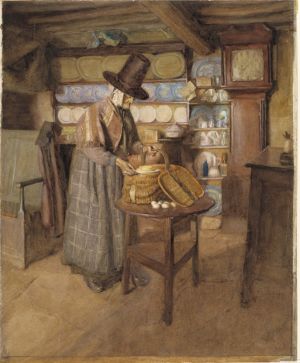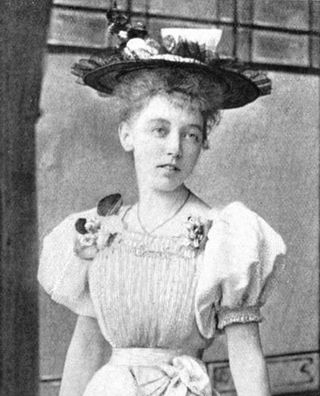
Royal Welsh Ladies' Choir was a performing group of women singers based in Cardiff, active from the 1880s until World War II.

Royal Welsh Ladies' Choir was a performing group of women singers based in Cardiff, active from the 1880s until World War II.


The Welsh Ladies' Choir was formed about 1883. Clara Novello Davies was its first leader, "a spirited conductress," [1] and its members (up to 70 singers) were drawn from her own students. The choir first toured America in 1887. In 1893, they won first prize for a ladies' choir at the Eisteddfod held in connection with the World's Columbian Exhibition in Chicago. In 1894 they became officially "Royal" with a command performance for Queen Victoria at Osborne House. A smaller group (about 24) toured the United States again in 1895. [2] In 1900, they won a prize at the Paris Exposition. [3]
Madame Hughes-Thomas, the second director of the Royal Welsh Ladies' Choir, was the daughter of Rev. Richard Hughes of Maesteg. [4] She attended the Royal Academy of Music in London. Hughes-Thomas was the second wife of Edward Thomas, the mayor of Cardiff. [5]
The Royal Welsh Ladies' Choir performed for the King Edward VII at Windsor Castle, and for the King and Queen on the Royal Yacht, at Queen Alexandra Dock in Cardiff in July 1907. [6] The next year (1908) they embarked on a series of extensive tours of North America, [7] including San Francisco, [8] Winnipeg, [9] Atlanta, [10] and several appearances in the coal towns of the Wyoming Valley. [11] [12]
In 1915, three choir members left in a salary dispute, while the choir was in Detroit. They sued Hughes-Thomas and went off to tour with Canadian entertainer Ada Cosgrove instead. [13] By 1919, Madame Hughes-Thomas was touring the United States with a group of just eight singers as the choir. [14]
In 1920, Dame Nellie Melba praised the choir: "The Royal Welsh Lady Singers are magnificent; they are perfectly splendid, and you may say I said so." [15]
Gertrude Gronow was conducted the choir of twelve to sixteen voices, performing tours in Pennsylvania in Pittston, [16] Canonsburg, [17] and Franklin. [18] In 1928, Clara Novello Davies returned to the helm in 1928 for a royal performance at Windsor Castle before the choir of sixty women departed for an Australian tour. [19] Muriel Jones conducted the choir in 1939. [20]

The culture of Wales is distinct, with its own language, customs, festivals, music, art, mythology, history, and politics. Wales is primarily represented by the symbol of the red Welsh Dragon, but other national emblems include the leek and the daffodil.

Maesteg is a town and community in Bridgend County Borough, Wales. Maesteg lies at the northernmost end of the Llynfi Valley, close to the border with Neath Port Talbot. In 2011, Maesteg had a population of 20,612. The English translation of Maesteg is 'fair field'.

Joseph Parry was a Welsh composer and musician. Born in Merthyr Tydfil, Wales, he is best known as the composer of "Myfanwy" and the hymn tune "Aberystwyth". Parry was also the first Welshman to compose an opera; his composition, Blodwen, was the first opera in the Welsh language.

Clara Novello Davies was a Welsh singer, teacher and conductor. She used the pen name Pencerddes Morgannwg.

Rhys Thomas "Rusty" Gabe born as Rees Thomas Gape, was a Welsh rugby union player who played club rugby for Llanelli, London Welsh and Cardiff and gained 24 caps for Wales, mainly as a centre.
Penarth Rugby Football Club is a Welsh rugby union club based since 1924 at The Athletic Field, Lavernock Road, in Penarth, in the Vale of Glamorgan in Wales.

Marie Novello, also known as Marie Novello Williams was a Welsh pianist. She was one of Theodor Leschetizky's last students and performed in public from childhood. Her early death cut short a promising career just as she began to record for one of the major English labels, having already amassed a considerable discography for one of its second-rank competitors.
This article is about the particular significance of the year 1894 to Wales and its people.
Only Men Aloud is a male voice choir from Wales. The choir came to national prominence in the UK when they won the Last Choir Standing competition run by BBC television during 2008.
Over the years Chicago has been called home by many immigrant groups and cultures, the Welsh included.

Norman Witchell Biggs was a Welsh international rugby union wing who played club rugby for Cardiff and county rugby for Glamorgan. Both Biggs and his brother Selwyn played international rugby for Wales, though they never played together in the same match for Wales. Biggs also played cricket for Glamorgan and in 1893 was part of a team that took on Cardiff in a two-day match; he faced his brother Selwyn, who was a member of the Cardiff team.
Tudor Davies was a Welsh tenor.

Merthyr Tydfil County Borough is a county borough in the south-east of Wales. In mid 2018, it had an estimated population of 60,183 making it the smallest local authority in Wales by both population and land area. It is located in the historic county of Glamorgan and takes its name from the town with the same name. The county borough consists of the northern part of the Taff Valley and the smaller neighbouring Taff Bargoed Valley. It borders the counties of Rhondda Cynon Taf to the west, Caerphilly County Borough to the east, and Powys to the north.

Llewela Davies was a Welsh pianist and composer who toured with Dame Nellie Melba.

Gwilym Gwent was a Welsh-born composer who immigrated in mid-life to the United States. He died on July 3, 1891.

Nellie Evans Packard was a Welsh-born American singer, voice teacher, arranger, and choir director based in Boston, Massachusetts.

Margaret Jane Bevan Geally, also called Maggie Bevan, was a Welsh-born child evangelist and singer, who twice toured the United States as a teenager, giving sermons and recitals in churches.
Beverley Anne Humphreys, MBE, is a Welsh operatic and concert soprano and broadcaster. She has become known for her work with refugees and in 2022 was awarded the MBE for "services to Community Cohesion and Broadcasting".

Mary Hannah John was a Welsh soprano singer who was involved with the 1904–1905 Welsh revival.
Esme Lewis, sometimes written as Esmé Lewis, was a Welsh singer. She was a member of the BBC Welsh Singers, and was regularly seen on the television program Gwlad y Gân from 1958 to 1964.